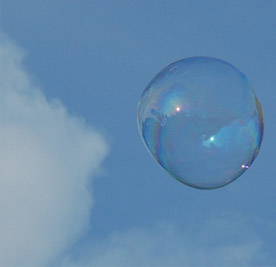|
I won a travel grant during the first three months of my PhD. One of my colleagues suggested that we make bubbles to help people understand membranes. Membrane's are the core study in our laboratory. With a poster in the University of Helsinki open house we started blowing soap bubbles illuminated by a black light. This was compared to liposomal or cell membranes being illuminated by fluorescent light.
The surface tension of bubbles is still different than liposomal membranes. Firstly, they have air in the middle and are not aqueous. Soap bubbles are also composed of surfactants rather (think of a single chained lipid) rather than a double chain. Lastly, their lipid tails point outwards towards the air with a thin layer of water present in the middle of surfactant layers.
From Soap Bubbles to Science
This thin layer of water between the soap is critical for the bubbles. The surface tension provides necessary wall tension. The bubble tends to minimize this wall tension pulling the bubble into a spherical shape. The spherical shape is governed by Young-LaPlace's equation. Adding glycerin makes the bubbles stronger by changing the surface tension at the soaps water interface making this layer more robust.
The equilibrium relationship between transmural pressure difference (dP), wall tension (T), and radius of curvature (R) in a concave surface; for a sphere: dP = 2T/R; for a cylinder: dP = T/R.
Thus pressure difference between the inside and outside of a bubble depends upon the surface tension and the radius of the bubble. The relationship can be obtained by visualizing the bubble as two hemispheres and noting that the internal pressure which tends to push the hemispheres apart is counteracted by the surface tension acting around the cirumference of the circle.
These Guys Understood the Surface Tension of Soap
Who made these relationships and the equation? In Physics and other natural sciences they name the discovery after you. In biology in particular you are allowed to give the latin name to animals and chemistry name an element like Curium. Being a dead scientist has its merits. At least the following two guys probably thought so.
For a 17th century polymath ThomasYoung was a rockstar. He studied everything from medicine, physics to Egyptian hieroglypics. Some of many achievements include partly deciphering the Rosetta Stone, understanding wave theory of light, analyzing language grammer from 400 different languages and of course the theory of capillary phenomena on the principle of surface tension which was later put into theYoung-Laplace equation.
Pierre Laplace a mathematician and astronomer also had great achievements on the other side of the English Channel in France. Not quite a rockstar but cool enough to make Napoleon laugh. He was even close to discovering black holes 100 years in advance of Hubble. He also understood probabilities and confused amused Napoleon on the religion. After looking into Young's a year after he understood the math behind it to make the Young-Laplace equation. This work was later unified and derived 25 years later by Carl Gauss to make a formula that describes the capillary pressure difference sustained across the interface between two static fluids e.g. water and soap.
So the next time you are in your back yard making soap bubbles think about surface tension and the people that derived the formula to understand your past time.
|
'Dyne With Me' explores surface tension of solutions used in everyday life. From inks to alcohol, drugs to dish soap, and everything in between....
Sunday, 1 April 2012
Surface tension of Soap Bubbles
Comments by IntenseDebate
Posting anonymously.
Surface tension of Soap Bubbles
2012-04-01T07:20:00-07:00
Unknown
kids|soap bubbles|Surface Tension|Thomas Young|wall tension|young-laplace equation|
Subscribe to:
Post Comments (Atom)


 Logging you in...
Logging you in...